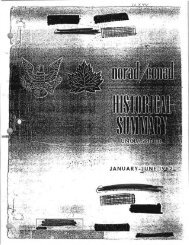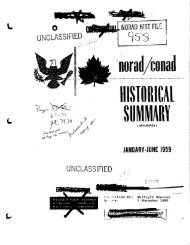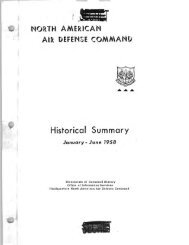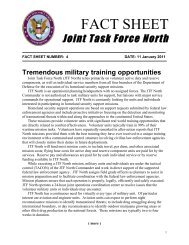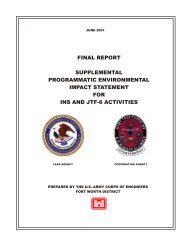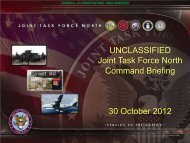(U) 1956-1957 NORAD CONAD History.pdf - US Northern Command
(U) 1956-1957 NORAD CONAD History.pdf - US Northern Command
(U) 1956-1957 NORAD CONAD History.pdf - US Northern Command
You also want an ePaper? Increase the reach of your titles
YUMPU automatically turns print PDFs into web optimized ePapers that Google loves.
u 'el<br />
·i<br />
3<br />
~ General, Partridge agreed, reiterating his views that "<strong>CONAD</strong> re- ~<br />
sponsibilities, initiall~y, should be limited to planning, requirements,<br />
operational control and deployment of air defense forces and to insure<br />
compatibility of air defense systems now under construction in all<br />
areas. "4 In addition, he reminded <strong>US</strong>AF that "All our actions should be<br />
guided by the ultimate aim of integrating the operational control of<br />
the air defense of Canada and the U. s. "5<br />
The JCS finished the revision by mid-<strong>1956</strong> and the Secretary of Defense<br />
approved it. The new Unified <strong>Command</strong> Plan gave CIN<strong>CONAD</strong> the responsibility<br />
of defending Alaska and the NOrtheast Area against air attack<br />
as well as the United Sta·ces, and of assisting in the air defense<br />
of Canada and Mexico. It also provided for the disestablishment of the<br />
U. s. Northeast <strong>Command</strong> on 1 September <strong>1956</strong>.<br />
study of Separation of <strong>CONAD</strong> and ADC<br />
In the meantime, a joint study was und~rway in Colorado Springs on<br />
reorganization of.<strong>CONAD</strong>. In December 1955, CIN<strong>CONAD</strong> bad directed that<br />
a joint study group be formed of component and <strong>CONAD</strong> officers to gtudy<br />
the feasibility and means of separating the <strong>CONAD</strong> and ADC staffs. '!he<br />
reason for wanting to separate the starfs and appoint a separate commander<br />
for ADC was that the ADC HeadqUB-~ers had not been able to function<br />
effectively as a joint headquarters. '!he combined, two-hat arrangement<br />
was not effective. It had been extremely difficult for the<br />
Air Force officers serving in dual capacities to adequately handle both<br />
positions. It had not been possible to clearly separate the functions<br />
of <strong>CONAD</strong> and its component commands and to recognize commend channels.<br />
~<br />
,- .<br />
' ..<br />
\ ) i<br />
I <br />
I<br />
Separation was necessary to increase CIN<strong>CONAD</strong>'s capability to exercise<br />
his major functions of pJanning and establishing air defe~e re- .<br />
quirements and of operationally controlling the air defense forces.<br />
General Partridge saw that the agency responsible for .Jair defense, the<br />
agency having operational control of the forces, had to be a clearly<br />
defined., separate organization. And the channels or means for exercising<br />
operational control had to be sepa.!'ate,i.e., they had to be through<br />
<strong>CONAD</strong>'s channels an~ not ADe's or ARADCOM's.<br />
'!he joint study group completed its work in March <strong>1956</strong>.<br />
Its study<br />
prcposed a separate staff consisting of a commander; chief of staff;<br />
secretariat; an., inf"ormation services; and deputies for plans and<br />
operations, communications and electronics, and intelligence.1 A staff'<br />
of 351 was proposed in the original study -- consisting of 118 officer"<br />
.160 enlisted men, and 13 civilians. Of the 118 officers, 23 were ArIIr3J<br />
u



